自考英语本科国际商务英语汉译英考试重点笔记
- 格式:docx
- 大小:33.13 KB
- 文档页数:2
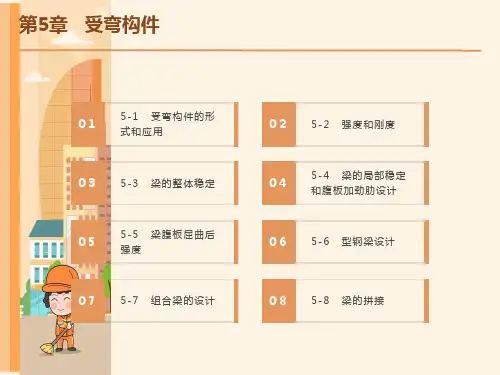
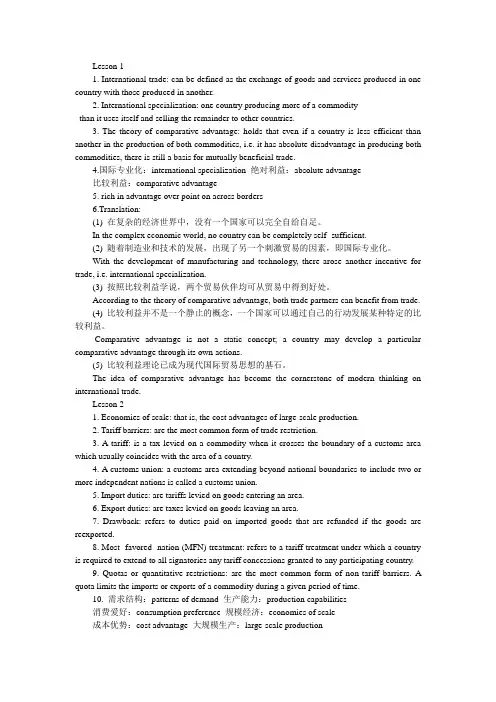
Lesson 11. International trade: can be defined as the exchange of goods and services produced in one country with those produced in another.2. International specialization: one country producing more of a commoditythan it uses itself and selling the remainder to other countries.3. The theory of comparative advantage: holds that even if a country is less efficient than another in the production of both commodities, i.e. it has absolute disadvantage in producing both commodities, there is still a basis for mutually beneficial trade.4.国际专业化:international specialization 绝对利益:absolute advantage比较利益:comparative advantage5. rich in advantage over point on across borders6.Translation:(1) 在复杂的经济世界中,没有一个国家可以完全自给自足。
In the complex economic world, no country can be completely self- sufficient.(2) 随着制造业和技术的发展,出现了另一个刺激贸易的因素,即国际专业化。
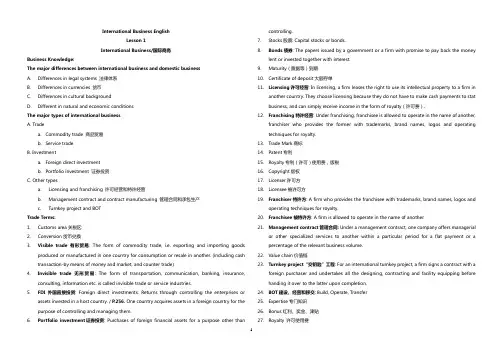
International Business EnglishLesson 1International Business/国际商务Business Knowledge:The major differences between international business and domestic businessA.Differences in legal systems 法律体系B.Differences in currencies 货币C.Differences in cultural backgroundD.Different in natural and economic conditionsThe major types of international businessA. Trademodity trade 商品贸易b.Service tradeB. Investmenta.Foreign direct investmentb.Portfolio investment 证券投资C. Other typesa.Licensing and franchising 许可经营和特许经营b.Management contract and contract manufacturing 管理合同和承包生产c.Turnkey project and BOTTrade Terms:1.Customs area关税区:2.Conversion货币兑换3.Visible trade有形贸易: The form of commodity trade, i.e. exporting and importing goodsproduced or manufactured in one country for consumption or resale in another. (including cash transaction-by means of money and market, and counter trade)4.Invisible trade无形贸易: The form of transportation, communication, banking, insurance,consulting, information etc. is called invisible trade or service industries.5.FDI外国直接投资: Foreign direct investments. Returns through controlling the enterprises orassets invested in a host country. / P.256. One country acquires assets in a foreign country for the purpose of controlling and managing them.6.Portfolio investment证券投资: Purchases of foreign financial assets for a purpose other thancontrolling.7.Stocks股票: Capital stocks or bonds.8.Bonds债券: The papers issued by a government or a firm with promise to pay back the moneylent or invested together with interest.9.Maturity(票据等)到期10.Certificate of deposit大额存单11.Licensing许可经营: In licensing, a firm leases the right to use its intellectual property to a firm inanother country. They choose licensing because they do not have to make cash payments to stat business, and can simply receive income in the form of royalty(许可费).12.Franchising特许经营: Under franchising, franchisee is allowed to operate in the name of another,franchiser who provides the former with trademarks, brand names, logos and operating techniques for royalty.13.Trade Mark商标14.Patent专利15.Royalty专利(许可)使用费,版税16.Copyright版权17.Licenser许可方18.Licensee被许可方19.Franchiser特许方: A firm who provides the franchisee with trademarks, brand names, logos andoperating techniques for royalty.20.Franchisee被特许方: A firm is allowed to operate in the name of another.21.Management contract管理合同: Under a management contract, one company offers managerialor other specialized services to another within a particular period for a flat payment or a percentage of the relevant business volume.22.Value chain价值链23.Turnkey project“交钥匙”工程: For an international turnkey project, a firm signs a contract with aforeign purchaser and undertakes all the designing, contracting and facility equipping before handing it over to the latter upon completion.24.BOT建设、经营和移交: Build, Operate, Transfer25.Expertise专门知识26.Bonus红利、奖金、津贴27.Royalty 许可使用费28.International investment国际投资: Supplying capital by residents of one country to another.29.Contract manufacturing承包生产30.GATT关贸总协定: General Agreement on Tariffs and Trade31.International business国际商务: Transaction between parties from different countries.Sometimes business across the borders of different customs areas of the same country is also regarded as import and export.32.Intellectual property知识产权33.Oil deposit: 石油储备= oil reserves34.the reserves of natural resources 自然资源储备35.Personal advancement个人的晋升,个人素质的提高以及个人事业的进步等。
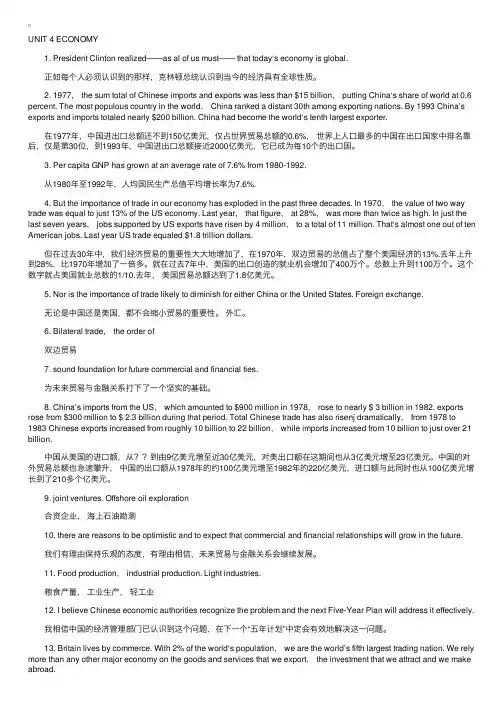
UNIT 4 ECONOMY 1. President Clinton realized——as al of us must—— that today‘s economy is global. 正如每个⼈必须认识到的那样,克林顿总统认识到当今的经济具有全球性质。
2. 1977, the sum total of Chinese imports and exports was less than $15 billion, putting China‘s share of world at 0.6 percent. The most populous country in the world, China ranked a distant 30th among exporting nations. By 1993 China’s exports and imports totaled nearly $200 billion. China had become the world‘s tenth largest exporter. 在1977年,中国进出⼝总额还不到150亿美元,仅占世界贸易总额的0.6%,世界上⼈⼝最多的中国在出⼝国家中排名靠后,仅是第30位,到1993年,中国进出⼝总额接近2000亿美元,它已成为每10个的出⼝国。
3. Per capita GNP has grown at an average rate of 7.6% from 1980-1992. 从1980年⾄1992年,⼈均国民⽣产总值平均增长率为7.6%. 4. But the importance of trade in our economy has exploded in the past three decades. In 1970, the value of two way trade was equal to just 13% of the US economy. Last year, that figure, at 28%, was more than twice as high. In just the last seven years, jobs supported by US exports have risen by 4 million, to a total of 11 million. That‘s almost one out of ten American jobs. Last year US trade equaled $1.8 trillion dollars. 但在过去30年中,我们经济贸易的重要性⼤⼤地增加了,在1970年,双边贸易的总值占了整个美国经济的13%.去年上升到28%,⽐1970年增加了⼀倍多。
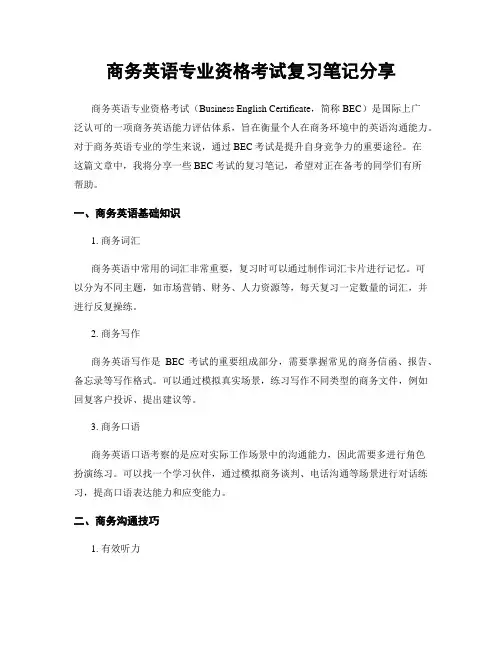
商务英语专业资格考试复习笔记分享商务英语专业资格考试(Business English Certificate,简称BEC)是国际上广泛认可的一项商务英语能力评估体系,旨在衡量个人在商务环境中的英语沟通能力。
对于商务英语专业的学生来说,通过BEC考试是提升自身竞争力的重要途径。
在这篇文章中,我将分享一些BEC考试的复习笔记,希望对正在备考的同学们有所帮助。
一、商务英语基础知识1. 商务词汇商务英语中常用的词汇非常重要,复习时可以通过制作词汇卡片进行记忆。
可以分为不同主题,如市场营销、财务、人力资源等,每天复习一定数量的词汇,并进行反复操练。
2. 商务写作商务英语写作是BEC考试的重要组成部分,需要掌握常见的商务信函、报告、备忘录等写作格式。
可以通过模拟真实场景,练习写作不同类型的商务文件,例如回复客户投诉、提出建议等。
3. 商务口语商务英语口语考察的是应对实际工作场景中的沟通能力,因此需要多进行角色扮演练习。
可以找一个学习伙伴,通过模拟商务谈判、电话沟通等场景进行对话练习,提高口语表达能力和应变能力。
二、商务沟通技巧1. 有效听力商务场景中的听力理解能力非常重要,需要能够听懂各种商务会议、电话交流等场景中的内容。
可以通过多听商务英语教材中的录音,同时注意提高听力速度和理解能力。
2. 跨文化沟通商务英语考试中也会考察跨文化沟通的能力,因此需要了解不同国家和地区的商务礼仪和文化习惯。
可以通过阅读相关书籍、观看纪录片等方式,了解不同文化之间的差异,提高应对跨文化沟通的能力。
3. 有效演讲商务英语考试中的演讲部分需要展示自己的表达能力和演讲技巧。
可以通过参加演讲培训班或者加入演讲俱乐部,提高自己的演讲能力和自信心。
三、备考技巧1. 制定合理的复习计划在备考BEC考试时,需要制定合理的复习计划,将复习内容分解为小目标,并合理安排每天的学习时间。
可以根据自己的实际情况,制定每天的学习计划,并坚持执行。
2. 多做模拟题BEC考试的题型比较固定,可以通过做模拟题来熟悉题型和提高解题能力。
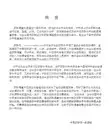
L1 International Business1.商务知识1.1major differences between international business and domestic businessA. differences in legal systemB. differences in currenciesC. differences in cultural backgroundD. differences in natural and economic conditions1.2 major types of international businessA. tradea. commodity(visible) tradeb. service(invisible) tradeB. investmenta. foreign direct investment(FDI)b.portfolio investmentstocks, bonds or certificates of depositsC. other typesa. licensing(high customs duty and non-tariff barrier, strong intellectual property protection)franchising(hotel and restaurant business)In comparison with the relation between the licenser and the licenser, the franchiser has more control over and provides more suppoort for the franchisee.b. management contract and contract manufacturingc. turnkey project and BOTL2 Income Level and the World Market1.商务知识1.1 GDP and GNPA. GDP market value of all goods and services produced within the geographic area of an economy.B. GNP market value of all goods and services produced by the property and labor owned by theresidents of an economy.1.2 per capita income and per capita GDP1.3 high income, middle income and low income countriesA. H: annual per capita income of $9386 and above;1). OECD; 2). rich oil producing countries of the Middle East; 3). small-industrialized countries orregions;B. M: annual per capita income below $9386 but above $765;1). most East European countries; 2). most members of the Commonwealth of Independent States; 3). 6OECD countries; 4). quite a number of Latin America countries; 5). some Asian countries; 6). South Africa, Libya, Nigeria and Algeria;C. L: annual per capita income of $765 and below;1). most African countries; 2). some Asian countries; 3).a few Latin American countries;1.4 Triad and QuadA. Triad: US, Western Europe and JapanB. Quad:Triad and Canada1.5 other important markets for Chinathe Four Tigers, the ASEAN countries, Russia, India and AustraliaL3 Regional Economic Integration1商务知识1.1 major objectives of regional integrationto better enjoy the benefit of free flow of goods,services,capital,labor and other resources.1.2 four levels of regional economic integrationA. free trade areaabsence trade barriers;the North American Free Trade Agreement(NAFTA, formed by US,Canada and Mexico);B. customs unionabsence trade barriers; practice of common external policy;Southern Cone Customs Union (Mercosur, formed by Argentina, Brazil, Paraguay and Uruguay in 1991);C. common marketabsence trade barriers; practice of common external policy; free production factor mobility;the European Community(1967-1994,became a true common market in 1992);D. economic unionabsence trade barriers; practice of common external policy; free production factor mobility;integration of the domestic policies;European Union;1.3 European Union(EU)A. historythe European Coal and Steel Community(ECSC,1952);the Treaty of Rome(1957,signed by France, Germany, Italy and the Benelux countries);the European Economic Community(EEC,1957-1967);the European Atomic Energy Community(EURATOM,1957-1967);the European Community(formed by merging ECSC,EEC and EURATOM,1967-1994);the Single European Act(1992);the Maastricht Treaty(1994);the European Union(1994-);B. structurethe European Commission(executive body);the Council of Ministers(decision making);the European Parliament(membership application and trade agreement approval);1.4 Asia-Pacific Economic Cooperation (APEC, has 21 members)A. the Seoul Declaration(1991);B. a five-layer organizational structure:the Informal Meeting of Economic Leaders(China,2001);the Dual-Ministerial Meeting;the Meeting for Ministers Responsible for Trade;the Senior Officials Meeting(SOM);Committee of Trade and Investment, Economic Committee, Economic and Technical Cooperation Subcommittee of SOM, and Budget Management Committee (four subordinate committees underSOM);C. objectives:trade and investment liberation and facilitation(TILF) and economic and technicalcooperation (ECOTECH);1.5 Organization of Petroleum Exporting Countries (OPEC,13 members,1960,Vienna)L4 Economic Globalization1. 商务知识1.1 economic globalization as an objective trendA. basic feature: free flow of commodity, capital, technology, service, and information inthe global context for optimized allocation;B. advantages and negative impactsa. advantages: 1).giving new impetus and providing opportunities to world economic development; 2),making the various economies more and more interdependent and interactive;b. disadvantage: making countries more vulnerable to the adverse events across the globe;1.2 multinational corporationsA. organization:parent MNC and affiliate MNCB. characteristics: 1). enormous size; 2). wide geographical spread; 3). longevity and rapid growth;C. two basic needs: profit and security;D. roles: as vehicles for cross-border transfer of resources;E. four types1). multi-domestic corporation(decentralized);2). global corporation(power and responsibility concentrated at the headquarters);3). transnational corporation(integrated in an independent network of affiliates);4). world company (internationalized)L5 International Trade (1)1. 商务知识1.1 the defintion of international tradethe exchage of goods and services produced in one country with those produced in anoother.1.2 two reasons for international tradeA. the uneven distribution of natural resources among countriesB. international specialization1.3 two theories for international specializationA. the theory of absolute advantagea commodity will be produced in the country where it costs least in terms of resources.B. the theory of comparative advantagea. contents of the theoryeven if a country is less efficient than another in the production of both commodities, there is still a basis for mutually beneficial trade.b. not a static conceptA country may develop a particular comparative advantage purely through its own actions.c. the cornerstone of modern thinking on international traded. David Ricardo, the economist who introduced the theoryL6 International Trade (2)1. 商务知识1.1 other bases for trade among countriesA. patterns of demandB. economy of scaleC. innovation or style1.2 the reasons why complete specializtion may never occurA. strategic or domestic reasonsB. transport costC. protectionist measures1.3 tariff barriers-- the most common form of trade restrictiona tax levied on a commodity when it crosses the boundary of a customs area.A. export duty (tax levied on goods leaving an area)B. import duty (tax levied on goods entering an area)a. specific dutyb. ad valorem dutyc. compound dutyC. drawback: duties paid on imported goods that are returned if the goods are reexported.D. MFN treatment: a tariff treatment under which a country is required to extend to allsignatories any tariff concessions granted to any participating country.1.4 quotas--the most common form of non-tariff barriersin quantity or valume terms, on a country or global basis, unilaterally or be negotiated on "voluntary"basis1.5 invisible tradeA. transportation service across national boundariesmaritime ships is the most important means (Greece and Norway have large maritime fleets)B. insurance (Lloyd's of London is a leading exporter of this service)C. tourismD. immigrant remittance: the money sent back to home countries by people working in a foreign landL7 Incoterms 20001. 商务知识1.1 the neseeity and purpose of having Incoterms1). to eliminate any of misunderstanding and subsequent dispute;2). to provide a set of international rules for the interpretation of the most commonlyused trade terms in foreign trade.1.2 the reasons for the 2000 revision of IncotermsA. spread of customs-free zonesB. changes in transportation practicesC. increased use of electronic communication1.3 the four groups of InsotermsA. Group E: the seller makes the goods available to the buyer at the seller's own premises;EXW (Ex Works);B. Group F: the seller is called upon to deliver the goods to carrier appoined by the buyer;FCA (Free carrier);FAS (Free Alongside Ship);FOB (Free On Board);C. Group C: the seller has to contract for carriage, but without assuming the risk of loss or damage to thegoods or additional costs due to events occurring after shipment and dispatch;CFR (Cost and Freight);CIF (Cost, Insurance and Freight);CPT (Carriage Paid To);CIP (Carriage and Insurance Paid to);D. Group D: the seller has bear all costs and risks needed to bring the goods to the country of destination;DAF (Delivered At Frontier);DES (Delivered Ex Ship);DEQ (Delivered Ex Quay);DDU (Delivered Duty Unpaid);DDP (Delivered Duty Paid)1.4 the three most commonly used termsA. FOB (free on board)B. CFR (cost and freight)C. CIF (cost, insurance and freight)1.5 chandges to some areasA. the customs clearance and payment of duty obligations under FAS and DEQ;B. the loading and unloading obligations under FCA;L8 Business Contract1. 商务知识1.1 the definition of the contractan agreement which sets forth binding obligations of the relevant parties.1.2 two types of business negotiation: oral and written1.3 process of negotiation and conclusion of the contractA. inquiry (enquiry)a first enquiry should content: 1). how the name and address of the exporter have been abtained; 2). thebusiness line and usual practice of the importer;B. quotationa firm offer should made of: 1). the time of shipment and the mode of payment desired;2). an exact description of the goods; 3). the validity period;C. offer and acceptanceD. counter-offera counter-offer may be made in relation to: 1). price; 2). terms of payment; 3). time of shipment; or 4).other terms and conditions of the offer;1.4 the necessity of the written contract: 1). as the proof of the agreement; 2). as the basis for its execution.1.5 the types of contractsA. sales contractB. purchase contractC. sales (or purchase) confirmation (less detailed than a contract)1.6 the setting of a contractA. the title: 1). the type of the contract; 2). the number of the contract; 3). the date;B. the contract propera. the name and address of the buyer and the sellerb. the details of the commodity transactionc. the terms and conditions mutually agreedd. indication of the number of original copies, language(s) used, and the validityC. the signatures of the contacting partiesD. the stipulations on the back of the contractL9 Modes of Trade1. 商务知识1.1 origin and development of counter tradeorigined from pre-World War II years when clearing system was introduced between familiar trading partners exchanging unrelated goods.1.2 current counter tradeA. barter: the direct exchange of goods and services which is completed in a short period of time.B. counter purchase: the assumption by an exporter of a transferable obligation through separate butlinked contract to accept as full or partial payment goods and services from the importer or importing country.C. buyback: an agreement by an exporter of plant and equipment to take back in the future part of theoutput produced by these goods as full or partial payment. The goods and services taken back are tied to the original goods exported (different from B).D. features common to the three forms of counter trade: "bundling"1.3 major advantages of counter tradeA. helping to deal with foreign exchange shortageB. promoting exportC. reducing uncertainty regarding export receiptsD. bypassing international price agreementE. helping countries with debt problems to import goods1.4 the drawbacks of counter trade: it can be very risk business.L10 International Payment1. 商务知识1.1 the complexity of payment in international tradeA. risks faced by the exporter and the importerB. political factors, commercial factors, grographical factors and language barrier etc.1.2 two methods of payment used under certain conditionsA. cash in advance or partial cash in advanceB. open accountC. consignment transaction1.3 the draft (bill of exchange)A. definitiondraft: an unconditional order to a bank or a customer to pay a sum of money to someone on demand orat a fixed time in the future.drawer: the person who draws the draft, usually the exporterdrawee: the person to whom the draft is drawn)payee: the person receiving the payment, usually the drawerB. sight draft (calls immediate payment on presentation)usance draft (tenor draft or term draft, is payable at a later date)C. clean draft (without documents)documentary draft (is accompanied by the relevant documents)1.4 documentary collectionA. documents against payment (D/P): documents will not be released to the importer until payment iseffected.a. D/P at sightb. D/p after sightB. documents against acceptance (D/A): documents are handed over to the importer upon his acceptanceof the draft drawn by the exporter.L11 The Letter of Credit (I)1. 商务知识1.1 the definition of the letter of credita letter issued by a bank at the request of the importer in which the bank promises to pay upon presentation of the relevant documents.1.2 the unique and characteristic feature of the letter of credit: bilateral security1.3 the relevant parties of the letter of credit and their roles in its process of operationA. the applicant (instructs his bank to issue an L/C)B. the opening bank (issues the credit and sends it to the advising bank)C. the advising bank (examines the credit and advises the beneficiary of its receipt)D. the beneficiary (examines the credit and requests the openerto make amendments to any discrepancies,then prepare the relevant documents and dispatch the goods)E. the negotiating bank (buys the exporter's draft submitted to it under the credit)F. the comfirming bank (adds its confirmation to the credit)1.4 the major contents of the letter of credit1). the number of the credit and the place and time of its establishment2). the type of the credit3). the contract on which it is based4). the major parties relevant to the credit5). the amount value of the credit6). the place and date on which the credit expires7). the description of the goods8). transportation clause9). stipulations relating to the draft10).stipulations concerning the shipping documents required11).certain special clause if any12).instructions to the negotiating bank13).the seal or signature of the opening bank14).whether the credit follows "the uniform customs and practice for documentary credits"1.5 the documents being the only concern of the banks in credit operation"in credit operations all parties concerned deal in documents, and not in goods, service and/or other performance to which the documents may relate"L12 The Letter of Credit (II)1. 商务知识1.1 major types of credits and their functions, forms and mechanismA. clean credit (only requirs clean draft for payment) and documentary creditB. revocable credit (commitments can be altered or even canceled without consulting with the beneficiary)and irrevocable creditC. confirmed credit (credit confirmed by a bank other than the issuing bank) and unconfirmed creditD. sight credit (payment can be made upon presentation of the draft and impeccable documents) andusance creditE. transferable credit (credit can be transferred by the original beneficiary to one or more parties) andnon-transferable creditF. non-draft credit (payment to be made by presentation of the documents without the formality ofdrawing and presenting a draft)a. payment creditb. deferred payment creditG. revolving credit (stipulated that its amount can be renewed or reinstated without specific amendment tothe credit being made)1.2 the limitations of the letter of creditA. inability to provide absolute securityB. being more expensive than other forms of paymentL13 Major Documents Required in Worlt Trade1. 商务知识1.1 the importance of correct documentation1).difficulties in taking delivery; 2).refusal by the bank to make payment,1.2 major types of documentsA. commercial invoicea. major contents1). invoice number and the date; 2). name and address of the buyer and the seller;3). contract number and credit number; 4). description of the goods;5). unit price, total price, price terms, and commission and discount if any;6). terms of delivery and terms of payment; 7). packing, shipping marks;8). seal or signature of the exporter;b. points to be noted: the description of the goods in the invoice must comply with the credit and thetotal invoice value should not exceed the total amount of the covering L/C.B. packing lista. major contents: the number, date, name and description of the goods, shipping marks, packing,number of packages, specific contents of each package and its net weight and gross weight etc.b. documents with similar function: specification list (emphasizes the description of specification of thegoods); weight list (also weight note or weight memo, emphasizes the weight of the goods and are used for goods which are based on the weight for price calculation)C. the bill of ladinga. 3 major functions1). as a cargo receipt2). constitutes a contract of carriage between the carrier and the consignor3). a document of title to the goodsb. major contents1). the carrier (shipping company); 2). the shipper or consignor (exporter);3). the consignee (the importer or made out "to order);4). the notify party (the agent of the consignee or the consignee himself);5). a general description of the goods; 6). shipping marks; 7). the freight;8). the port of shipment and the port of destination; 9). the place where the bill of lading is issued;10). the date when the bill of lading is issued;c. clean bill of lading (states that the goods have been shipped in apparent good order and condition)and on board bill of lading (indicates that the shipment has been actually loaded on the carrying vessel bound for the port of destination)d. ocean bill of lading,airway bill and railway bill, cargo receipt;D. insurance policy and insurance certificatea. major contents1). the insured; 2). cargo description; 3). the amount insured and the risks covered; 4). contentsconcerning transportation; 5). the place where claims are to be settled;6). the date on which the document is issued;b. the difference between the two: the latter is a bit simpler than the formerE. various certificatescertificate of quality, certificate of weight, certificate of quantity, certificate of health, certificate of disinfection, certificate of origin, veterinary certificate etc.F. other documentscustoms invoice, consular invoice, consular visa, shipping advice etc.L14 International Transportation1. 商务知识1.1 definitiontransportation: the movement of freight and passengers from one location to another. freight transportation: the economic movement of commodities and products and the effect of such movement on the development and advancement of business.1.2 the five major modes of transportation: water, rail, truck, pipeline, and air.1.3 three types of carriersA. common carriersB. contract carriersC. private carriers1.4 importance, role, and contribution of transportationtransportation plays a major role in the production process; it moves raw material, inter-mediate product between producers and finished products to consumers; by widening the market areas that a producer canreach, it encourages the introduction of more efficient, larger-scale production techniques;1.5 the four factors that are substantially changing transportationA. transportation deregulationB. just-in-time inventory systemC. competition based on high levels of customer serviceD. globalization of business2.生词与短语primitive, in a broad/formal sense, grocery, stringent, shackle, limelight, logistics, committed to, thrusted sb./sth. into the limelight, dockside, at an ever-accelerating pace, innovation,3. 商务术语freight transportation, freight system, natural product provinces, volume loading and unloading machinery, common carrier, contract carrier, private carrier, production process, intermediate products, production techniques, economies of scale, per-unit production costs, commercial intercourse, service packages, just-in-time inventory system, production approach, production input, globalization of business, distribution manager, logistics system,L15 Insurance (I)1. 商务知识1.1 definitiona social device in which a group of individuals transfer risk and provides for payment of losses from funds contributed by all members who transferred risk.1.2 the idea of a known premium vs. the uncertainty of risk1.3 the common pool and the advantages enterprises can gain from it the main stimulus to enterprise is the release of funds.1.4 insurance for overseas tradeA. necessityIn bridging both the geographical gap and the time lag serious risks have to be run.B. functionmoving the burden of risk from the shoulders of the exporters and importers, and placing it upon the shoulders of specialist risk-bearing underwriters,it is the handmaiden of commerce.L16 Insurance (II)1. 商务知识1.1 three main principles of insuranceA. insurable interest: no one may insure anything unless he has an interest in it.B. utmost good faith: the people who decide what premium is fair for a particular cover do so on the basisof written statements made in a proposal form.C. indemnity (not apply to life or personal accident insurance): a contract of insurance is one whichrestores a person who suffered a loss into the same position as he was in before the loss occurred.1.2 two sub-principles of insuranceA. contribution: a person cannot be allowed to insure twice for the same risk, and claim compensationfrom both insurers.B. subrogation: when the cargo A insured with B is damaged by C's negligence, B will be substituted for Ain any legal action against C.1.3 the doctrine of proximate cause (the direct cause of the loss): when an insurance policy is made out to cover a certain risk, a claim becomes payable only if that risk occurred as the proximate (closest) cause of the loss suffered.1.4 three basic types of marine insuranceA. free from particular average (F.P.A.)B. with particular average (W.A. or W.P.A)C. all risksL17 International Monetary System and Exchange Rate1. 商务知识1.1 the international monetary systemA. sterling-based gold standard (19C--1918)B. dollar-based gold standard (1945--1971.8)C. the floating system (1971.8--)1.2 exchange rateA. fixed exchange rateby which each country pegged its currency to gold to establish its par valueB. flexible exchange ratemajor currencies float in the foreign exchange market; other currencies follow a fixed exchange rate by pegging themselves to a major currency and float with it.C. major factors influencing exchange ratea. international balance of paymentthe value of one's own currency will go up with favorable balance of payment;b. inflationwhen inflation intensifies, the value of the currency will drop;c. interest ratehigh interest rate will increase the exchange rate of one's own currency;D. common measures for intervention in exchange ratea. buying or selling foreign currencywhen the price of a foreign exchange goes too high, the central bank may sell it out of its foreign exchange reserves;b. raising or lowering discount ratewhen the price of a foreign exchange goes too high, the government may raise the discount rate to absorb foreign fund;c. foreign exchange controlwhen the exchange rate fluctuates violently, a government may have to resort to foreign exchange control to make up its BOP deficit and lower the demand for foreign exchange;E. the pros and cons of the two different kinds of exchange ratethe fixed exchange rate system reduces the riskiness of international business and curbs inflation, but it is vulnerable to disorderly changes in currency value; the flexible exchange rate system protects domestic currency from the impact of foreign idle funds and fluctuations of exchange rate, and is helpful to the stability of the economy, but frequent wild swings of the value of currencies will increase the riskiness of trade and affect international investment.F. direct quote (the price of a foreign currency in terms of the home currency)indirect quote (the price of home currency in terms of a foreign currency)G. buying price (the rate by which a commercial bank buys a currency)selling price (the rate by which a commercial bank sells a currency)medial price (the average of the buying price and the selling price)L18 International Financial Organizations1. 商务知识1.1 the World Bank GroupA. constituent parts: IBRD, IDA, IFC, MIGAB. objectives: to help raise standards of living in developing countries by channelingfinancial resources to them from developed countries.1.2 the International Bank for Reconstruction and Development (IBRD,1945)A. source of its capital1). subscribed by its members;2). comes from its retained earnings and the flow of repayments on its loans;B. financing of its lending operations (from its own borrowings in the world capital market)C. operation of loans grantinga. repayment time (15-20 years) and grace period (5 years)b. target countries (developing countries)c. interest rate (calculated according to a guideline related to its cost of borrowing)D. basic rules governing its operation1). must lend only for productive purposes and must stimulate economic growth in the developingcountries;2). cannot finance a trade deficit, but can finance an infrastructure project;3). must pay due regard to the prospects of repayment;4). the decisions to lend must be based on economic considerations alone;1.3 the International Development Association (IDA,1960)A. relation with IBRD and membershipaffiliated to IBRD;membership in IDA is open to all members of the IBRD.B. objective: providing assistance for the poorer developing countries with soft loansC. source: 1).subscriptions, general replenishments from developed members;2). transfers from the IBRD;D. terms of credits: only to governments; 10Ys grace periods and 35-40Ys maturities; without interest.1.4 the International Finance Corporation (IFC,1956)A. function: to assist the economic development of LDCs by promoting growth in the private sector oftheir economies and helping to mobilize domestic and foreign capital;B. relation with IBRDa separate entity, affiliated to IBRD and draws upon the Bank for administrative and other services;membership in the IBRD is a prerequisite for membership in the IFC;1.5 Multilateral Investment Guarantee Agency (MIGA)A. mandate: to encourage equity investment and other direct investment flows to LDCs through themitigation of noncommercial investment barriers;B. ways for carrying out the mandate。
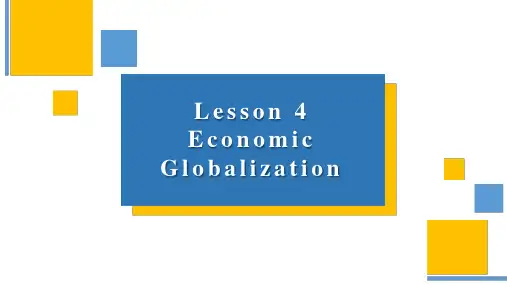


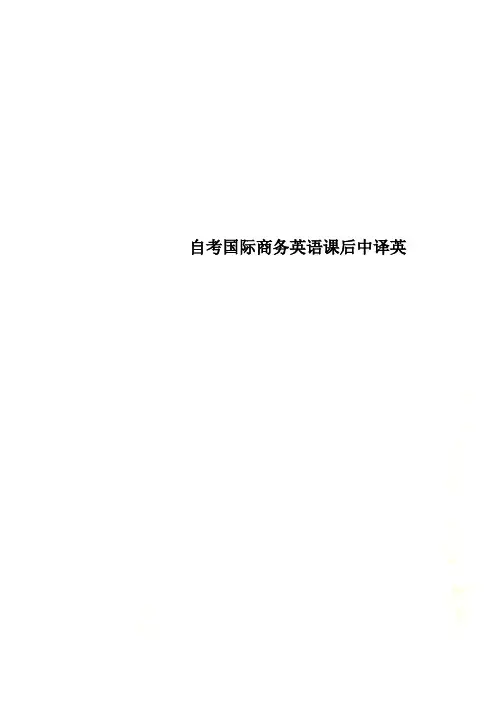
自考国际商务英语课后中译英Lesson 11.国际贸易一般指不同国家的当事人进行的交易,它涉及到许多因素,因而比国内贸易要复杂得多。
International business refers to transaction between parties from different countries, it involves more factors and thus is more complicated than domestic business.2.随着经济一体化进程的发展,很少人和公司能完全独立于国际商务之外而存在。
因此,在此方面具有一定的知识是十分必要的,这既有益于企业的发展又有益于个人的进步。
With the development of economic globalization, few people or companies can completely stay away form international business. Some knowledge in this respect is necessary both for the benefit of enterprises and personal advancement.3.其他参与国际贸易的形式有管理合同、承包生产和“交钥匙”工程。
Other forms for participating in international business are management contract, contract manufacturing and turnkey project.4.国际贸易最初以商品贸易的形式出现,即在一国生产或制造商品而出口或进口到另一国进行消费或转售。
International businessfirst took the form ofcommodity trade, i.e.exporting and importinggoods produced ormanufactured in onecountry for consumptionor resale in another.5.除了国际贸易和投资,国际许可和特许经营有时也是进入国外市场的一种方式。
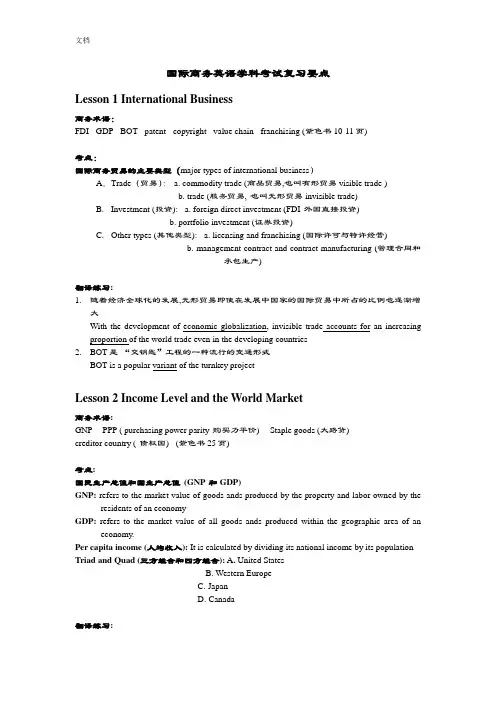
国际商务英语学科考试复习要点Lesson 1 International Business商务术语:FDI GDP BOT patent copyright value chain franchising (紫色书10-11页)考点:国际商务贸易的主要类型(major types of international business)A.Trade(贸易):a. commodity trade (商品贸易,也叫有形贸易visible trade )b. trade (服务贸易, 也叫无形贸易invisible trade)B. Investment (投资): a. foreign direct investment (FDI 外国直接投资)b. portfolio investment (证券投资)C. Other types (其他类型): a. licensing and franchising (国际许可与特许经营)b. management contract and contract manufacturing (管理合同和承包生产)翻译练习:1.随着经济全球化的发展,无形贸易即使在发展中国家的国际贸易中所占的比例也逐渐增大With the development of economic globalization, invisible trade accounts for an increasing proportion of the world trade even in the developing countries2.BOT是“交钥匙”工程的一种流行的变通形式BOT is a popular variant of the turnkey projectLesson 2 Income Level and the World Market商务术语:GNP PPP ( purchasing power parity 购买力平价) Staple goods (大路货)creditor country ( 债权国) (紫色书25页)考点:国民生产总值和国生产总值(GNP 和GDP)GNP: refers to the market value of goods ands produced by the property and labor owned by the residents of an economyGDP:refers to the market value of all goods ands produced within the geographic area of an economy.Per capita income (人均收入): It is calculated by dividing its national income by its population Triad and Quad (三方组合和四方组合): A. United StatesB. Western EuropeC. JapanD. Canada翻译练习:1.国民生产总值和国生产总值体现了一个国家的全部收入,在衡量国民收入方面可以互换使用。
自考“英汉翻译教程”复习笔记Translation ConclusionUnit 1 stories1. He was thirty-six,his youth had passed like a screaming eagle,leaving him old and disillusioned.他已三十六岁,青春像一路鸣叫的鹰,早已一闪而逝,留给他的是衰老和幻灭。
2. average height 普通高度3. gleaming eyes 两眼闪着光辉4. in his middle twenties 大概是二十五六岁的年龄5. ignoring the chair offered him,Chu The stood squarely before this youth more than ten years his junior and in a level voice told him who he was,what he had done in the past,how he had fled from Yunnan,talked with Sun Yat-sen,been repulsed by Chen Tu-hsiu in Shanghai,and had come to Europe to find a new way of life for himself and a new revolutionary road for China.朱德顾不得拉过来的椅子,端端正正地站在这个比他年轻十岁的青年面前,用平稳的语调,说明自己的身份和经历:他怎样逃出云南,怎样会见孙中山,怎样在上海被陈独秀拒绝,怎样为了寻求自己的新的生活方式和中国的新的革命道路而来到欧洲。
6. When both visitors had told their stories,Chou smiled a little,said he would help them find rooms,and arrange for them to join the Berlin Communist group as candidates until their application had been sent to China and an answer received.两位来客把经历说完后,周恩来微笑着说,他可以帮他们找到住的地方,替他们办理加入党在柏林的支部的手续,在入党申请书寄往中国而尚未批准之前,暂时作候补党员。
国际商务英语05844江苏自考汉译英国际商务英语05844江苏自考汉译英LESSON 1 INTERNATIONAL BUSINESS国际商务1. 国际贸易一般指不同国家的当事人进行的交易,它涉及到许多因素,因而比国内贸易要复杂得多。
International business refers to transaction between parties from different countries. It involves more factors and thus is more complicated than domestic countries.2. 随着经济一体化进程的发展,很少人和公司能完全独立于国际商务之外而存在。
因此,在此方面具有一定的知识是十分必要的,这既有益于企业的发展又有益于个人的进步。
With the development of economic globalization, few people or companies can completely stay away from international business. Therefore, some knowledge in this respect is necessary both for the benefit of enterprises and personal advancement.3. 其他参与国际贸易的形式有管理合同、承包生产和“交钥匙”工程。
Other forms for participating in international business are management contract, contract manufacturing, and turnkey project.4. 国际贸易最初以商品贸易的形式出现,即在一国生产或制造商品而出口或进口到另一国进行消费或转售。
International business first took the form of commodity trade, i.e. exporting and importing goods produced or manufactured in one country for consumption or resale in another.5. 除了国际贸易和投资,国际许可和特许经营有时也是进入国外市场的一种方式。
自考“英汉翻译教程”复习笔记(11)自考“英汉翻译教程”复习笔记(11)20. 外汇帐户,外汇管理条例,Foreign exchange transactions. Regulations on foreign exchange control.21. 合营企业所需原材料,燃料,配套件等,应尽先在中国购买,也可由合营企业界自筹外汇,直接在国际市场上购买。
In its purchase of required raw and processed materials. Fuels,auxiliary equipment,etc. an equity joint ventures should first give priority to purchases in China. It may also make such purchases directly on the world market with foreign exchange raised by itself.22. 外籍职工,个人所得税,不可抗力,全国人民代表大会Foreign employee. Individual income tax. Force majeure. National People‘s Congress.UNIT 10 SPEECHES1. distinguished guests. On behalf of. Incomparable hospitality.诸位贵宾。
谨代表。
盛情款待。
2. Never have I heard American music played better in a foreign land.我在外国从来没有听到过演奏得这么好的美国音乐。
3. gracious and eloquent remarks. Common ground. At the outset. Common interests.盛情和雄辩的讲话。
自考商务英语翻译知识点自考商务英语翻译有哪些重要的知识点呢?接下来店铺为你整理了自考商务英语翻译知识点,一起来看看吧。
自考商务英语翻译知识点(一)1. Enclosed please find a copy of our price list.随函附上我方价目表一份,请查收。
2.However,up to the present writing, we have not had the pleasure of hearing from you. 然而,迄今为止未见贵方赐复。
3. We should be much obliged if you could make us a firm offer for 100 tons. 如能报给我方一个100的实盘,我方将不胜感激。
4.Your early reply will be highly appreciated.Your prompt cooperation will be highly appreciated.5. If you will kindly inform us as to his financial standing, reliability andreputation for paying bills, we shall greatly appreciate the favor. 如蒙贵方将他的信用状况及付款方面的信誉状况告知我方,我方将非常感激。
6....fall/come within the scope of our business activities...是我们的业务范围7.....enter into/establish direct business relations 建立直接的业务关系8.FOB:Free on Board 离岸价 CFR;Cost and FreightCIF;Cost,Insurance and Freight9. pay on demand 见票即汇 at a future fixed timeBearer 持票人 at a 60 days sightSight bill 即期汇票 time bill 远期汇票Seventy-five thousand only(整)Negotiable 转让 drawer 出票人 drawee 授票人 endorsement 背书10.Collection 托收 Document Against Payment D/P 付款交单Document Against Acceptance D/A 承兑交单Shipping documents货运单据: Performa invoice 形式发票,Commercial invoice商业发票, Bill of landing提单(B/L)Inspection certificate 商检证 Shipping advice 装运通知Policy of insurance 保险单 Customs declaration 报关单Bill of exchange 汇票(Draft) Letter of Credit 信用证(L/C)Certificate of origin 产地证明 Clean bill 清洁提单 Unclean bill12.Effect/make paymentThe full payment is effectedEffect/make shipment (of the ordered goods)13. PS: Poster Script 备注14.Rules in Business English(5C)Clear. Concise. Complete. Correct. Concrete.15. Irrevocable L/C 不可撤销的L/CRevocable L/C 可撤销的L/C16.词语叠用Sole and exclusive Effective and efficient Final and conclusive True and correct Force and effect Type and kind Power and authority Obligation and responsibilityBind and obligate Finish and completeRelieve and discharge Request and demand自考商务英语翻译知识点(二)1. This company specialized in importing textile.我们公司专营纺织品的进口业务。
英译汉1.Domestic business 国内商务国内商务2.economic 2.economic globalization 经济全球化球化3.host country 东道国东道国 intellectual4.property intellectual 4.property 知识产权知识产权5.non-tariff barriers 非关税壁垒非关税壁垒6.national product 国民产值国民产值7.per capita GDP人均国内生产总值8.Durable equipment耐用设备9.Staple goods大路货10.Creditor country债权国11.Customs union关税同盟12.Dual-Ministerial meetings 12.Dual-Ministerial meetings 双部长会议双部长会议13.European Commission 欧盟委员会anization of Petroleum Exporting Countries(OPEC)石油输出国组织 15.North American Free Trade Agreement(NAFTA)15.North American Free Trade Agreement(NAFTA)北美自由贸易协北美自由贸易协定16.Board of directors 董事会17.day to day running 日常管理18.the parent MNE 18.the parent MNE 多国公司目公司多国公司目公司19.national economic welfare 国家经济利益20.the legal jurisdiction 法律经管范围21.self-sufficient 21.self-sufficient 自给自足的自给自足的22.farm produce 农农品23.the endowments of nature 自然禀赋24.perfect competition 完全竞争25.output per many-year of labour人均年产量26.production capability 生产能力27.consumption preference 消费偏好28.cost advantage 成本优势rge-scale production大规模生产30.tariff barrier关税壁垒31.International Chamber of Commerce国际商会32.customs clearance结关33.EDI电子数据交换34.Incoterms国际贸易术语解释通则35.destination port目的港36.binding obligation有约束力的义务37.international trunk call国际长途38.the business line业务范围39.force majeure不可抗力40.cross-border contract进出口合同41.clearing system清算系统42.leverage杠杆作用43.trade credit account贸易信贷往来账户44.centrally planned economy中央计划经济45.financial status财务状况46.to open account开立账户47.Consignment transaction寄售交易48.a usance draft远期汇票49.documentary collection跟单托收50.impeccable documents正确无误单据51.correspondent bank往来行52.confirming bank保兑行53.transportation clause运输条款54.clean credit即期信用证55.deferred payment credit不可转让信用证56.freight prepaid运费预付57.prepare documents缮制单据58.consignor托运人59.consular invoice领事发票60.notify party被通知人61.contract carriers契约承运人62.intermediate product半成品63.ultimate consumers最终消费者64.natural product province产品自然领域65.time lag 时差66.claim on goods 对货物的索赔67.premium 保险费68.insurer 承保人69.insurable interest 可保利益70.settlement of a claim 理赔71.freight forwarder 货运代理行72.utmost good faith 最大诚信原则73.valued policies 有价保单74.exchange rate 买入价75.balance of payment 收支平衡76.direct quote 直接标价77.buying rate 买入价78.financial policies 金融政策79.financial policies 资金80.retained capital 预留资金81.grace period 优惠期82.a specialized mandate 特殊使命83.direct investment 直接投资84.tax holiday 免税期 85.greenfield strategy 绿地战略86.customer mobility 客户流动87.investment return 投资回报88.start from scratch 政府债券89.market maker 股票经营商90.standing committee 常务委员会91.underlying securities 基础证券92.global trade rules 世界贸易规则93.the reciprocal tariff concession list 互惠关税减让表94.a uniform tariff system 统一关税体系95.the non-discrimination principle 非歧视原则96.escape clause 豁免条款97.a new economic order 新经济秩序98.trade concession 贸易减让99.Special Drawing Rights 特别提款权100.maturity 100.maturity 到期日到期日101.certificate of deposit 101.certificate of deposit 大额大额102. cartel 102. cartel 卡特尔卡特尔汉译英1.1.国际商务国际商务international business2.2.无形贸易无形贸易invisible trade3.3.国内生产总值国内生产总值gross domestic products4.4.证券投资证券投资portfolio investment5.5.交钥匙工程交钥匙工程turnkey project6.6.国民生产总值国民生产总值Gross National product Gross National product((GNP GNP))7.7.收入分配收入分配income distribution8.经济合作与发展组织the Organization for Economic Cooperation and Development9.9.基础储备基础储备infrastructure10.10.外汇储备外汇储备foreign currency reserves11.11.区域经济一体化区域经济一体化regional economic integration12.12.自由贸易区自由贸易区free trade area13.13.欧盟欧盟European Union14.14.亚太经合组织亚太经合组织Asia Pacific Economic Cooperation(APEC)16.16.部长理事会部长理事会Council of Ministers17.17.经济全球化经济全球化Economic Globalization 18.18.跨国企业跨国企业multinational economic environment19.19.生产设施生产设施manufacturing facilities20.20.自然资源分配自然资源分配the distribution of nature resources21.21.初级产品初级产品the primary commodities22.22.比较优势论比较优势论the theory of comparative advantage23.23.互利贸易互利贸易the mutual beneficial trade24.24.资源储备资源储备资源储备 the reserves of natural resources the reserves of natural resources25.25.技术创新技术创新technology innovation26.26.贸易方式贸易方式patterns of trade27.27.关税区关税区customs area28.28.自动出口限制自动出口限制voluntary export restraint29.29.名胜古迹名胜古迹places of historical interest30.30.贸易条款贸易条款trade terms31.31.修改信用证修改信用证amendment to the letter of credit32.32.集装箱运输集装箱运输container transport33.33.运费付至运费付至CPT34.34.报价报价quotation35.35.有效期有效期the validity period36.36.付款方式付款方式modeOf payment37.37.仲裁仲裁arbitration38.38.对销贸易对销贸易cunter trade39.39.实际头寸实际头寸net positions40.40.双边协议双边协议bilateral agreement41.41.易货贸易易货贸易barter42.42.垂直合并,纵向组合垂直合并,纵向组合vertical combination43.43.汇率浮动变化汇率浮动变化exchange rate fluctuation44.44.资信状况资信状况credit standing45.45.分期付款分期付款payment by installments46.46.即期汇票即期汇票sight draft47.47.付款交单付款交单document against payment document against payment((D/P D/P))48.48.商业信用证商业信用证commercial letter of credit49.49.开证行开证行the opening bank50.50.受益人受益人the beneficiary51.51.统一惯例统一惯例the uniform customs and practice52.52.循环信用证循环信用证revolving credit 53.53.保兑信用证保兑信用证confirmed credit54.54.远期信用证远期信用证usance credit55.55.票面价值票面价值face value56.56.资金周转资金周转capital turnover57.57.空运提单空运提单airway bill58.58.产地证书产地证书certificate of origin59.59.运输标记运输标记shipping marks60.60.装运港装运港port of shipment61.61.原始的生产方式原始的生产方式primitive mode of production62.62.竞争机制竞争机制competition system63.63.运输体系运输体系transportation system64.64.公共承运人公共承运人common carriers65.65.保证金保证金margin66.66.股票投资股票投资investment in stocks67.67.货物保险货物保险cargo insurance68.68.外汇储备外汇储备foreign exchange services69.69.共同基金共同基金the common pool70.70.代位追偿代位追偿subrogation71.71.近因原则近因原则the doctrine of proximate cause72.72.预约保单预约保单open policy73.73.平安险平安险F.P.A74.74.水渍险水渍险W.P.A75.75.金本位制金本位制gold standard76.76.平价平价par value77.77.布雷顿森会议布雷顿森会议the Bretton Woods Conference78.78.间接标价间接标价indirect quote79.79.储备货币储备货币reserve currency80.80.世界资本市场世界资本市场World capital market81.81.借贷成本借贷成本the cost of borrowing82.82.产权产权产权((股票股票))投资equity investment83.83.经济结构调整经济结构调整economic restructuring84.84.合资公司合资公司joint venture85.85.并购并购acquisition86.86.生物遗传学生物遗传学biogenetics87.87.自动出口限制自动出口限制Voluntary Export Restriction Voluntary Export Restriction((VER VER))88.88.证券交易所证券交易所the Stock Exchange Market 89.89.普通股普通股ordinary share90.90.补偿基金补偿基金compensation fund91.91.金边债券金边债券gilt92.92.期权期权option93.93.协商机制协商机制a consultative mechanism94.94.双边谈判双边谈判bilateral negotiation95.95.签约国签约国the signatory countries96.96.充分就业充分就业full employment97.97.多边贸易体制多边贸易体制multilateral trade system98.98.国际组织国际组织international organizations99.99.技术转让技术转让technology transfer100.100.商品协议商品协议commodity agreement101.101.国际货币体系国际货币体系international monetary system102.102.优惠关税优惠关税preferential preferential((customs customs))tariff103.103.承包生产承包生产Contract manufacturing104. tariff rates 关税率105. settlement 105. settlement 协议协议106.Shareholders 股东股东107.board of directors 董事会 108.parent company 母公司 109.affiliate 子公司 110.day-to-day running 日常管理 101.multinational corporation 跨国公司跨国公司102.home country 母公司所在国母公司所在国103.host country 东道国 术语解释1.affiliate MNC: a MNC which is associated or controlled by its parent MNC without losing its own identity.2.Absolute advantage: an advantage possessed by a country engaged in international trade when, using a given resource input, it is able to produce more output than other countries possessing the same resource input.3.Arbitration: the setting of a dispute by means of a neutral third party rather than by a court of law.4.A correspondent bank: a bank which acts 4.A correspondent bank: a bank which acts as an as an as an agent agent for another bank.5.All 5.All risks: risks: risks: extensive extensive extensive insurance coverage insurance coverage insurance coverage of cargo, of cargo, of cargo, including including coverage due to external causes such as fire, collision, pilferage etc., but usually excluding ”special” risk such as those resulting from acts of war, labor strikes and the perishing of good, and from internal damage due to faulty packaging, decay or loss of market.Buyback: an agreement by an export of plant and equipment to take back in the future part of the output produced by these goods as full or partial payment.Bill Bill of exchange: of exchange: of exchange: a a a signed signed signed document document document that that that orders orders orders a person a person a person or or or an an organization, such as a bank, to pay a fixed sum of money on demand or on a certain date to the person specified.Capital: the contribution to productive activity made by investment in physical capital and in human capital.Customs clearance: the formalities necessary to satisfy the customs officers before they will allow goods to the cleared from customs for dispatch or delay elsewhere.Banknotes circulation: movement of the printed paper money issued by a bank, usually the country’s central bank.Contract: a legally binding agreement made between two or more people.Clause: part of a legal document that deals with a particular item or condition in it.Confirmed credit: a letter of credit to which a number of other document such as shipping documents have been joined by the exporter to obtain payment from the bank.Commission: the amount paid to an agent, which may be an individual, a broker, or a financial institution, for consummating a transaction involving sale or purchase of assets or services.Commercial invoice: a document identifying numbers such as invoice number, date, shipping date, mode of transport, delivery and payment terms, and a complete listing and description of the goods or services being sold including prices, discounts and quantities.Common pool: a fund contributed by all insured parties in the name of premium against certain risk, outof which the claims if those suffering losses are paid.capital infrastructure: the basic physical requirements, without without which which which the the the industry industry industry cannot cannot cannot function effectively, function effectively, function effectively, water water and electricity installations, qualified and killed professionals in technology and administration.Capital market: markets where corporations and governments sell securities to investors in order to raise funds for long or short periods.Consumerism: considerable desire to make purchase for consumption.Distributor: a person who sends goods from those who produce them to them to those who use them.Documents against acceptance(D/A): documents are handed over to the importer upon his acceptance of the bill of exchange drawn by the importer upon his acceptance of the bill of exchange drawn by the exporter. Payment will be paid on a laterdate.Documentary credit: a letter of credit to which a number of other documents such as shipping documents have been joined by the exporter to obtain payment from the bank.Devaluation: the act of a government in reducing by law the exchange exchange value value value of of of its currency its currency its currency in in in units of units of units of gold gold gold or as or as or as compared compared with other currencies.Envisage: picture in the mind as a future possibility; imagine Economic of scale: the long-run reduction in average costs that occurs as the scale of the firm’s output is increased./the reduction in unit cost and increase in profit obtained when goods are produced in large quantities.EDI: an electronic system that sends specially-prepared document direct from the computer of one company to that of another, so avoiding delays and improving services to customers.Equity investment :a type of investment by buying the ordinary shares of a company.Exchange rate: the ratio between one currency unit and the number of number of units units units of another of another of another currency at currency at currency at which which which it it it is possible is possible is possible to to exchange the two at a given time.Economic integration: economic integration is a term used to describe how different aspects between economic are integrated. As economic integration increase, the barriers of trade between markets diminishes. The most integration economy today, between independent nations, is the European Union and its euro zone.FOB FOB: in foreign trade contracts, the seller’s delivers the : in foreign trade contracts, the seller’s delivers the goods on board the ship named by the buyer at the named port of of shipment. shipment. shipment. From From From that that that point, point, point, all all all charges charges charges and and and risks risks risks have have have to to to be be borne by the buyer.Fair trade: in international trade, the principle that maintains that there should only be free trade with those countries which themselves extend free trade.Full employment: an economic situation in which all persons physically and mentally capable of doing some kind of work, canfind employment.Gold reserves: the stock of gold coin and bullion held by a note-issuing bank in country on the gold standard. GNP : refers refers to to the market market value value of goods and services produced by by the the property property and and and labor owned by labor owned by labor owned by the the the residents residents residents of of of an economy an economy GDP : refers to the market value of all goods and services produced within the geographic area of an economy.Host country: in international trade, the country in which a multinational corporation is active, but which is not the home country of that corporation.Hyperinflation: an extreme form of inflation; the situation that exists in a Economy when the money supply is being increased very rapidly, resulting in an increase of over 20%in the annual growth of the money supply or of the price level. Infrastructure: large-scale public services, such as water and power supplies, road, rail and radio communication,etc. needed to support economic activity, esp. industry, trade and commerce.Integration: combine into a whole.Inflation: a general rise in prices within an economy, accompanied by a reduction of the value of money.International trade: the exchange of goods and services between countries through exports and imports.Irrevocable credit: a letter of credit to which the paying bank has added its guarantee that payment will be made against presentation of certain documents.Intermediate products: goods that enter into the production of other goods. In the manufacturing process, goods and materials pass through various states of production, frequently requiring transfer from one plant to another or sale by one firm to another.Indemnity: a basic idea in all branches of insurance that the insured should be in the same position after a loss as he as be was before it, i.e. neither richer nor poorer as a result of loss.Intellectual property: certain non-tangible assets held,principally covering the areas of patent protection,registered trade marks and designs, and copy right.Joint venture: a commercial undertaking by two or more people,differing from a partnership in that it relates to thedisposition of a single lot of goods or the termination of aspecific project.just-in-time inventory: making or ordering only just enoughparts or materials for the factory’s immediat immediate e needs, soavoiding the expense of keeping stocks.Liberalize: of trade, the act of government in lifting controlover import and exports.Letter of credit: A written instruction by a bank or some otherfinancial institution. To its agent or another bank, eitherlocal local or or or aboard, to aboard, to aboard, to lend lend lend the bearer the bearer the bearer of of of the letter certain sums the letter certain sumsof money for a fixed period of time.Loan: a commercial transaction between two legal entitieswhereby one party, known as lender agrees to put at the disposalof another known as a borrower certain property, usually money ,for its temporary use, with am understanding by both partiesthat the property will be returned. Money circulation: money in the hands of the public and beingused to pa for goods and services.Most-favored nation Most-favored nation clause: clause: clause: an an an understanding principle understanding principle understanding principle of the of theWTO whereby each country undertakes to apply the same rate oftariff to all its trade partners.Negotiable transport document: transport document can betransferred from one person to another by endorsement.Non-tariff barriers: all public regulations and governmentpractices that introduce unequal treatment for domestic andforeign goods of the same or similar production.North American free trade agreement(NAFTA 北美自由贸易协定):NAFTA is a trade agreement between Canada, Mexico, theunited states, which entered into force on january1,1994. Itwas preceded in 1988 by a trade agreement covering Canada andthe U.S.U.S.——the Canada –U.S. free trade agreement, which servedas a negotiating framework for the expanded agreement.Option: a contractual agreement between a buyer and a sellerto buy or sell a particular security commodity or currency ata specific price within a pre-determined period of time.Partnership: a contractual Partnership: a contractual relationship relationship relationship undertaking by undertaking by undertaking by two or two ormore people, differing from a partnership in that it relatesto to the the disposition of disposition of a a a single single single lot lot lot of of of goods or the termination goods or the terminationof a specific project.PPP: purchasing power parity.Protectionism: the deliberate use or encouragement ofrestrictions on imports to enable relatively inefficientdomestic producers to compete successfully with foreignproducers.Productivity: the relation between the output or amountproduced in a given period and one unit of the factors ofproduction employed in producing that output.Preferential customs tariff: a lower (or zero) tariff on aproduct from one country than is applied to imports from mostcountries. This violation of the MFN principle is permitted inspecial cases.Per capita income : It is calculated by dividing its nationalincome by its populationQuota: a Quota: a limit limit limit placed by placed by placed by a a a government government government on the on the on the amount amount amount of imports of importsor commodity.Revenue: the money received by a firm from selling its outputof goods or services or money earned by government fromtaxation.Reserves: in a business, amount set aside from profits to meetcontingencies or for future investment.Specialization Specialization: : to restrict one’s economic activities tocertain particular field.Subrogation: the legal right of an insurer to receive any moneyobtained by the insured as a result of his making use of hisrights against third parties; this reduces the cost of the lossto the insurer and prevents the insured from obtaining more thanhis full indemnity.Stock exchange: a markets where stocks and shares are boughtand sold under fixed rules, but at princes controlled by supplyand demand.Settlement: a payment of money claimed.Tariff Tariff: a form of tax that occurs as the scale of the firm’s : a form of tax that occurs as the scale of the firm’soutput is increased./the reduction in unit cost and increasein profit obtained when goods are produced in large quantities.Terms of payment: the terms agree upon between a sellers anda buyer regarding a transaction with respect to the mode andtime-table of payment.Trade fair: a big exhibition where manufactures and sellers anda similar or related products display their goods, meetcustomers and each other.Transfer Transfer of technology: of technology: of technology: a a a complicated complicated complicated aspect of international aspect of internationalbusiness. Technology can be divided into two types: non-tacitand tacit. It can be transferred through various modes, eitherexport of products and goods or though service. The mostimportant feature of technology transfer is it is a transferof the right to use, not the right to ownership.Terms of trade: a measure of the trading success of a countryby comparing the prices of its imports with the prices of its exports.Triad and Quad : A . United StatesB. Western EuropeC. JapanD. CanadaW.P.A: a wider coverage than the F.P.A. partial loss of ordamage to damage to the insured goods the insured goods the insured goods is is is excluded only excluded only excluded only where where where the loss the loss the loss to tothe insurer and prevents the insured from obtaining more thanhis full indemnity.简答1.Major difference between international business anddomestic business: A . differences in legal system; B.differences in currencies;C . differences in culturalbackground; D . differences in natural and economic conditions.2.Major types of international business: A. tradea. Commodity tradeb. Service tradeB. investmenta. foreign direct investmentb. portfolio investmentC. other typesa. licensing and franchisingb. management contract and contract manufacturingc. turnkey project and BOT3.Explain the concepts of GNP and GDP respectively and point out their major difference. Can we use them interchangeably? GNP refers to the market value of goods and services produced by the property and labor owned by the residents of an economy. GDP measure the market value of all goods and services produced within the geographic area of an economy. The difference between between GNP GNP GNP and and and GDP GDP GDP is that is that is that the the the former former former focuses om ownership focuses om ownership focuses om ownership of of the factors of production while the latter concentrates on the place where production while the latter concentrates on the place where production takes place. We can use them interchangeably.4. what is the free trade area? And what is Customs union? In what way is a customs union different from a free trade area. Free trade area is the first trade area is the first and loosest and loosest and loosest form of regional form of regional economic integration. Members of a free trade area area removes barriers to the flow of goods and services among themselves while each member still adopts its own policy as regards to trade with outsiders. Custom Union is the second form of regional economic integration that goes a step farther by adopting the same trade policy for all the members toward countries outsides their organization in addition to abolishing trade barriers among themselves . Since imports from other other countries countries are subject subject to to the same tariff no matter matter which which member they export export to, to, it is impossible for non-members to get into the market of the customs union in a detour as they possibly do in the case of trade with a free trade area.5. Describe briefly the characteristics of MNEs.①they are usually enormous in size in terms of the amount of annual sales and of resources it controls.②they have a wide geographical spread, and ②they have a wide geographical spread, and seek to set up an seek to set up an integrated production and distribution network in the world. ③MNEs enjoy longevity and rapid growth. They have a long development history and rapid growth record.6. how are MNEs usually usually operated? operated? operated? And And how are important decision made?①the operation ofMNES is under the control of parent MNE at their home countries. ②the affiliate MNEs also have their own decisionmaking mechanism, however the major decision, such as those on corporate goals, new investment and their location are made by parent MNEs.8. Which theory makes more sense, absolute absolute advantage advantage advantage or or comparative advantage. Comparative advantage sound more plausible .As it is very difficult to find for a country a product with absolute advantage, and also, a country still gains from trade for its products with comparative advantages.9. What are the important factors that one has to take into account when talking about the possibility of international specialization?Whether the internationalization will happen or not is decided by trade patterns, economic of scale, innovation.The production capacity and conditions decide what a country can produce and trade, the economies of scale decides if a country has a cost advantage for the traded product, and the innovation decides if the traded product is competitive in the foreign market.10. Why is it necessary to have Incoterms? And what is the purpose of making amendments and additions to Incoterms? The purpose of Incoterms is to provide a set of international rules for the interpretation of the most commonly used trade term in foreign trade, thus, the uncertainties of different interpretation of such terms in different countries can be avoided or at least reduced to a considerable degree.And the purpose of making amendments and additions is in orderto bring the rules in line with current international trade practices.11. What contents should be included in a firm offer?A firm offer s a promise to sell goods at a stated price. The major terms include time of shipment, made of payment, description of goods and validity period.12.Give the major item of the contract proper.This includes four major parts: the full name and address of the buyer and seller; the description of the commodities; the terms and conditions for the transaction; indication of the number of original copies of the contract and other additional terms.13. Please Please define define define counter counter counter trade. trade. trade. What What are the possible reasons for its attraction. An umbrella term for several sorts of trade in which the seller is required to accept goods or other instruments or trade, in partial or whole payment for its products. Counter trade transactions include barter, buyback, or compensation, compensation, offset offset requirements, and clearing agreements. Counter trade is allegedly popular in less development countries and in planned economies, it attracted much interest in the past. Now as the landscape od landscape od economic system economic system economic system drastically drastically drastically changed changed changed recently, recently, recently, it it attracts much more attention.14.What is the difference between a clean draft anda documentary draft?For a clean draft, it is a draft without attached additional documents; for a documentary draft, it is a draft supported supported by by title documents, such as an invoice, bill of lading or insurance policy. In fact everything having a real commercial value is know as a documentary draft.15.How dose L/C offer security to the buyer and the seller? ①it enable exporters obtain, through a correspondent bank,duarantees that the invoice for goods sent by them will actually be paid by the buyer actually be paid by the buyer——the importer.②it also provides the buyer with a guarantee that goods will be received in good order, for L/Cs are subject to appropriate。
1国际贸易一般指不同国家的当事人进行的交易,它涉及到许多因素,因而比国内贸易要复杂得多。
International business refers to tr ansaction between parties form d ifferent countries. It involves mor e factors and thus is more compl icated the domestic business. .随着经济一体化进程的发展,很少人和公司能完全独立于国际商务之外而存在。
因此,在此方面具有一定的知识是十分必要的,这既有益于企业的发展又有益于个人的进步。
With the development of econo mic globalization, few people or companies can completely stay a way from international business. Therefore, some knowledge in thi s respect is necessary both for t he benefit of enterprises and per sonal advancement.其他参与国际贸易的形式有管理合同、承包生产和“交钥匙”工程。
Other forms f or participating in international b usiness are management contract, contract manufacturing and turn key project.国际贸易最初以商品贸易的形式出现,即在一国生产或制造商品而出口或进口到另一国进行消费或转售。
International busin ess first took the form of comm odity trade, i.e. exporting and im porting goods produced or manuf actured in one country for consu mption or resale in another .除了国际贸易和投资,国际许可和特许经营有时也是进入国外市场的一种方式。
Besides trade and inve stment, international licensing an d franchising are sometimes take n as a means of entering a forei gn market.国民生产总值和国内生产总值是表明一国收入的两个重要概念。
区别在于前者强调的是生产要素的所属权而后者着重于进行生产的国家。
GNP and GDP are two important concepts used to indi cate a country’s total income. Th e difference between them is tha t the former focuses on ownershi p of the factors of production w hile the latter concentrates on th e country where production takes place.要评估某一市场的潜力,人们往往要分析其收入水平,因为它为那里居民的购买力高低提供了线索。
In assessing the potential of a co untry as a market, people often look at per capita income since i t provides clues about the purch asing power of its residents. 世界各国被世界银行分为三大领域:高收入国家,中等收入国家和低收入国家。
Countries of the world a re divided by the World Bank int o three categories of high-income, middle-income and low-income economies.中国现在年人均收入为1100美元以上,但几年前它还是个低收入国家。
China with a per ca pita income of over $1100 is a middle-income country though it was a low-income country just a few years ago.就中国来说,周围还有其他应特别关注的市场,如亚洲四小虎、东盟国家、俄罗斯等国,这些国家都具有前景看好的市场潜力,能为中国提供很好的商机。
As far as China is concerned, other markets we should pay particular attention to are those around u s: the Four Tigers, the ASEAN co untries, Russia, etc. These countri es with very promising market p otential and can offer good busin ess opportunities to China. 过去的几十年,地区经济一体化越来越重要。
The past decades witn essed increasingly growing import ance of regional economic integra tion.最著名的自由贸易区是北美自由贸易区,它是由美国、加拿大和墨西哥于1991年建立的。
The mos t notable free trade area is the North American Free Trade Agree ment (NAFTA), the largest free m arket formed by the United State s, Canada and Mexico in 1991. 经济联盟成员国不仅要在税收、政府开支、企业策略等方面保持一致,而且还应使用同一货币。
The mem bers of an Economic Union are r equired not only to harmonize th eir taxation, government expendit ure, industry polices, etc., but als o use the same currency. 欧洲委员会是欧盟的管理机构之一,此机构将提议呈交给部长理事会做决定,并监督各成员国根据所制定的条约履行自己的义务。
The Euro pean Commission is one of the g overning organs of the European Union. It is the body that puts p roposals to the Council of Minist er for decision and sees that the members carry out their duties under the treaty. APEC 建立于在澳大利亚首都堪培拉召开的一次部长级会议上。
当时有12位成员国出席,分别为澳大利亚、美国、加拿大、日本、新西兰和东盟六国。
APEC was set up at the Ministeri al Meeting held in the Australian capital Canberra attended by 12 members of Australia, the Unite d States, Canada, Japan, Republic of Korea, New Zealand and six ASEAN countries.经济全球化为世界经济发展提供了新的动力和机会,同时也使各经济体更加相互依赖、相互影响。
Economic globalization is giving new impetus and provid ing opportunities to world econo mic development and meanwhile making the various economies more and more interdependent.跨国公司是在一个以上国家拥有、控制和经营资产的商业组织。
A m ultinational enterprise is a busine ss organization that owns (wheth er wholly or partly), controls and manages assets in more than o ne country. 许多人欢呼经济全球化带来的好处,但同时也有强烈的反对声音。
While many people ar e acclaiming the benefits brought about by economic globalization, there are also loud vices of opp osition.除了总部以外,跨国企业组织也可能有不同的地区总部和业务总部。
An MNE may also have va rious regional or operational hea dquarters, in addition to internati onal headquarters. 跨国公司的内部交换占整个国际贸易的一个很大的比例。
The transfer of the Intra-MNE transactions constitutes a v ery significant proportion of total international trade. 尽管公司的日常管理工作下放到跨过企业的子公司,但重要决策,如有关公司目标和新投资等都由母公司来决定。
Although the day-do-day running of corporate operation maybe de centralized to the affiliate MNCs, the major decisions, such as tho se on corporate goals and new i nvestments are made by the par ent company. 无论人们是否喜欢,经济全球化已成为世界经济发展中的一个客观趋势。